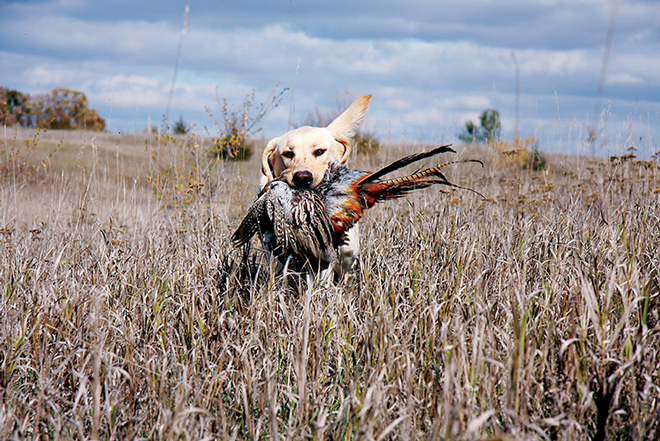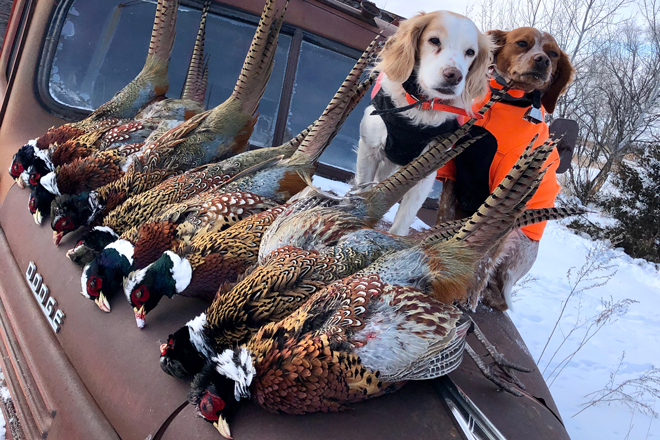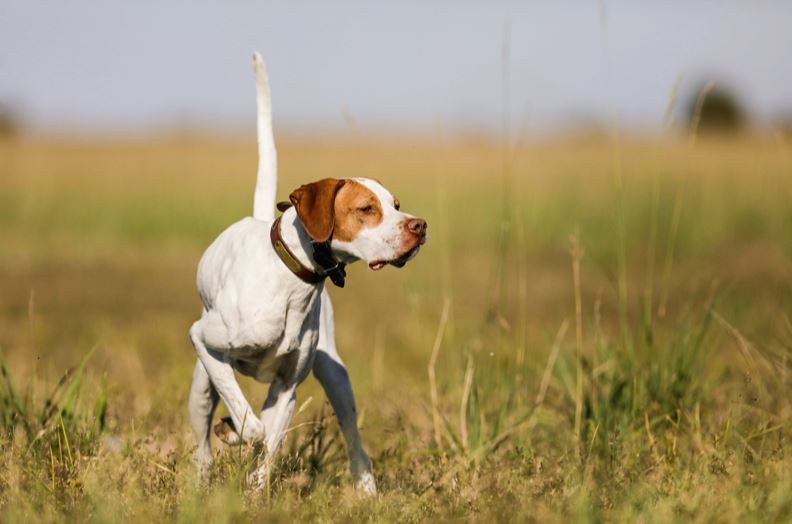Unpacking the 7 most contentious bird dog debates
By Andrew McKean
There are almost as many myths and misconceptions in our relationship with our dogs as there are dogs. And these misunderstandings go way beyond the backyard varieties about the dubious correlation between tail-wagging and happiness, or wet noses and health.
Belief in canine myths, or unwavering adherence to a singular training style, can have real-world implications. We deprive our hunting dogs of proper nutrition because we blindly follow this year’s dietary trend. Or we have unrealistically high expectations of our dog’s ability because we’ve gotten all our guidance from a YouTuber with unlimited resources and time. Or we mistake a training regimen for a one-and-done tune-up and don’t follow through with the sort of focused repetition that separates a good dog from a finished dog.
But it’s not all your fault. The world of gundogs, dog training and canine health is full of mutually exclusive tribes and conflicting — if not diametrically opposing — information. If you subscribe to one style of training, for instance, you can’t take key points from the next. If you build your world around retrievers, you can’t learn anything from the pointer club.
All of this is nonsense, of course. The gift of dog partnership — beside drifts of sloughed hair, unexpected vet bills and too-brief membership in our family — is the handmade relationship you create with your bird dog using relevant knowledge from the wide world of canine experience. A smart trainer is one who borrows tips and insights … and questions conventional wisdoms.
With that in mind, let’s examine a number of long-held opinions about the nature, and nurture, of pheasant dogs. We’ll provide the experts’ insights ... you make your own calls.
SPAY YOUR DOG BEFORE HER FIRST HEAT CYCLE
BACKGROUND
If you don’t intend to breed her, you’re faced with this decision early in your career with your female. There are real medical implications to the decision. Some experts claim that waiting exposes your dog to greater risk of breast cancer. Too early, and you interrupt hormones important for long-term health.
INSIGHT
“I tell owners the decision to spay or not to spay — and when to do it — is all about mitigating risk,” says Seth Bynum, DVM, a general practitioner in Lewiston, Idaho, who specializes in canine reproduction. “Females spayed before the first heat cycle are at greater risk for developing urinary incontinence down the road, while those spayed after the first heat have an increased risk of mammary tumors later in life. Unspayed females are highly prone to potentially deadly uterine infections later in life. Subjectively, I see more obese females that were spayed prior to the first heat. Early spaying has also been linked to increased risk of cancer in some breeds, as well as increased risk of some serious sports injuries, namely cruciate ligament rupture.”
“For hunting dogs that are not intended for breeding, I think spaying after the first heat cycle strikes a good balance, assuming the owners have the means to prevent a pregnancy during that fertile period,” he says.
MALE DOGS HAVE MORE HUNTING DRIVE THAN FEMALES
BACKGROUND
We’ve all heard this: Male dogs are naturally more aggressive, and that aggression translates into hunting drive — the innate ability to hunt harder, longer and with more intensity.
INSIGHT
When it comes to bird dogs, we routinely mistake physical ability for hunting drive, says Dr. Ira McCauley, DVM, owner of Momarsh and Habitat Flats in north-central Missouri, one of the premier waterfowl lodges in North America.
“First, you gotta realize, I’m biased,” says McCauley. “I like female dogs. I don’t like dogs that pee on everything and think that’s more important than listening to me. Drive-wise, I don’t think there’s a difference. When it comes to physical ability, yes, there’s a difference. In a Lab, a real tall male that’s intact and looks like Superman and can wade through 18 inches of water is going to beat out a female who’s 40 pounds and has to swim. But that’s a matter of physicality, not drive. If it’s a dry-ground deal, she might beat him. More importantly, she’s more likely to listen to me, be a better-trained dog, and therefore a smarter and more effective hunter.”

INTACT MALES HAVE MORE HUNTING DRIVE THAN NEUTERED MALES
BACKGROUND
This is a corollary to the previous question. The idea is: Intact male dogs are the complete package, and their reproductive plumbing is tied to their “alpha-ness” which is expressed in hunting intensity.
INSIGHT
“It’s important to note that science has not weighed in on this question,” says Bynum. “It’s all subjective, but in my experience, having hunted with both intact and altered dogs, there is no difference in prey drive. That urge comes from between the ears, not between the legs. It’s buried deep in their DNA, tying together their nose and brain in a sensory experience that is likely more seductive than the urge to breed.”
DO WHATEVER YOU CAN TO GET PICK OF THE LITTER
BACKGROUND
The concept that we want to have first choice of the puppies in a litter assumes two things: that the qualities you seek in a mature gundog are evident in an 8-week-old puppy, and that you have the ability to recognize them. Both ideas are questionable.
INSIGHT
Instead of trying to pick out an individual puppy from the litter, spend your time choosing the litter, says Barton Ramsey, owner of Southern Oak Kennels in Mississippi and a top Labrador trainer.
“In all of my breedings, I have rarely ever seen the characteristics demonstrated at eight weeks old still present in the fully-grown gundog,” says Ramsey. “In other words, rarely is the biggest puppy the biggest gundog, or the calmest puppy the calmest gundog. Your best bet is to pick a litter that you 100-percent believe in, based on parents’ abilities, health test results and pedigree, and grab a pup from the bunch.”
McCauley says picking a puppy is a little like trying to predict whether a kindergartner will become a lawyer. Instead of looking for cues that might indicate medical conditions, or field-worthiness, he watches how littermates interact.
“You can learn a lot about a dog’s social skills from that first visit,” he says. “If you have a puppy that’s aggressive and has social issues, you can often pick up on that. But every puppy is a crapshoot,” McCauley continues. “They’re not clones. Every litter will have good ones, crappy ones, and middle-of-the-road ones. If you want a sure thing, you’re better off buying a started dog because you’ll know what you have in term of health and ability.”
POINTING BREEDS ARE BETTER SUITED TO PHEASANT HUNTING THAN RETRIEVERS
BACKGROUND
If you haven’t participated in this debate, can you really call yourself a pheasant hunter? The myths are twofold. Pointing dogs locate and hold birds, but can be ambivalent about post-shot responsibilities of retrieving. Retrievers run wild, bumping birds and wreaking havoc among more civilized breeds, but shine when it comes to finding a downed bird and bringing it to hand.
INSIGHT
First, understand that there’s no way to satisfactorily answer this question in any kind of absolute sense. It’s the bright line that divides gun dog owners, and each tribe will find evidence to support their taste. Instead of conclusions, here are some perspectives.
“To me, a wounded bird that you never find doesn’t do you any good,” says McCauley, making the case for retrievers. “I love to hunt over any dog that gets birdy, but whether I kick up a pointed bird or whether the dog flushes it, I don’t care. What matters to me is ensuring that he finds and brings to hand a wounded bird. So I feel that the retrieve after the shot is more important than the style prior to the shot.”

Bynum, who has hunted over pointers, springers, English cockers and Labs but who owns a brace of German shorthaired pointers, observes that Labradors and other retrieving breeds all seem to retrieve more naturally with less training involved in getting a shot bird to hand.
“However, I once hunted over a Lab that required us to sprint to the downed pheasant before she turned it into a meal,” he says. “Personally, I’m partial to the versatile breeds.”
MY DOG CAN TELL THE DIFFERENCE BETWEEN A ROOSTER AND A HEN
BACKGROUND
Hunt pheasants long enough and you’ll encounter the dog handler who claims he can predict the gender of the bird that his dog points: A hen will elicit a subdued response in the dog, but a rooster will sharpen his intensity and stiffen his points.
INSIGHT
Maybe. Bynum notes that human brains just can’t comprehend the rich detail that dogs extract from each sniff.
“Some dogs can detect changes in blood sugar in their diabetic owners, others can key in on a few ounces of drugs or explosives among an olfactory smorgasbord,” he notes. “With experience, our dogs can certainly tell a pen-raised planted bird from a wild one, so why couldn’t they distinguish between hens and roosters? I think the more important question is, do they care?”
Ramsey is more circumspect.
“Half the time, your buddies can’t tell the difference between a rooster and a hen,” he says. “While there might be a very slight scent difference between hens and roosters, it is certainly not consistent enough to teach a dog to recognize one over the other. The dog’s job is to point, or flush, and/or to retrieve. Our job is to be the judge of whether or not it’s a bird we should shoot.”
A GREAT PHEASANT DOG IS BORN: ALL THE TRAINING IN THE WORLD CAN’T OVERCOME INNATE ABILITY
BACKGROUND
This is the universal question that bears not just on dogs, but on humans, horses and homing pigeons as well. A great dog is a product of nature. Or is it a product of nurture — all the training that your pour into it? Spoiler alert: Don’t expect a conclusive answer here.
INSIGHT
“It’s both nature and nurture,” says Bynum. “It’s almost cliché, but the adage ‘It takes birds to make a bird dog’ is still sound advice. There is no trainer on the planet that provides a richer experience for the bird dog than the birds themselves.”

“I’m fortunate to live in an area with abundant wild birds,” he continues, “so I spend a great deal of my training focusing on basic obedience. I let the birds teach the dog all they need to know about pointing, backing, crowding and honoring. I just do a little polishing. When they’re ready, I take their already strong retrieving desire and make it consistent and automatic. This process is far easier in a dog with lots of drive and natural ability than a lazy couch potato that would rather chase biscuits than birds.”
Ramsey also thinks great dogs can be born, but they can also be built.
“The greatest dogs come from a little bit of both nature and nurture,” he says. “Breeding can account for good health, good drive, good instincts. Training takes all those great characteristics and puts them to proper use. Big drive is great, but it’s so much better when the dog knows how to wait patiently to be sent before unleashing it. A fantastic nose is often a natural trait, but it’s so much better when the dog uses it within gun range rather than finding and flushing every bird within the county while you sprint to keep up.”
McCauley leans slightly more toward nature than nurture.
“Look at human kids,” he says. “You can have country kids who are exposed to the outdoors all their lives but would rather sit on a couch playing video games than playing in the mud. But you can also have a kid who was raised indoors all their lives who, given a chance, can’t get enough of playing in the creek and shooting BB guns and getting muddy, even though their parents didn’t expose them to that stuff.”
“I think you have a better chance of molding a dog than you do a kid,” he laughs, “but I think the nature determines the level a dog reaches as much or more than training does. If that wasn’t the case, then every trainer would have an exact recipe of what every dog will do every month. And you know that doesn’t happen. Some dogs take a month to force fetch. Other dogs take three days. Some dogs get the ability to remain steady to shot automatically. Some dogs never get it. That’s nature expressing itself differently in every single dog.”
Andrew McKean and his yellow Lab Nellie ponder the mysteries of bird dogs from their home near Glasgow, Montana.
This article originally appeared in the Summer 2019 Bird Dogs Issue of Pheasants Forever Journal.